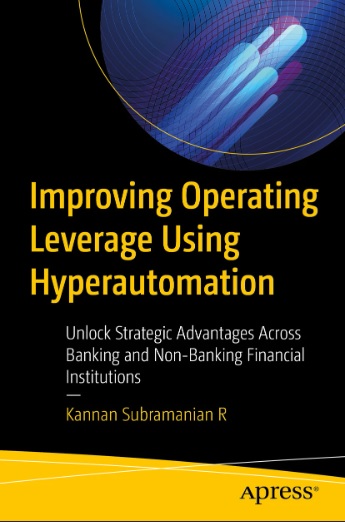In late 2018, EAPJ published a review of the book Bank of the Future: Minimise Technology Risk, Maximise Business Return. One of the book’s authors, Kannan Subramanian R, has now released a new book entitled Improving Operating Leverage Using Hyperautomation. Still centred on the Financial Services industry, but with a particular focus on Operating Leverage within complex banking environments, the author has provided the following overview.

Improving Operating Leverage Using Hyperautomation
by Kannan Subramanian R
A Complex Banking Operating Environment is characterised by hardwired architecture, siloed processing and fragmented data. These environments are ‘application or function centric’ where data is a “by-product”. The enterprise architecture transformation should change the shop floor from a mix of disparate systems and multiple data repositories into an intelligent, end-to-end process automated, event and services driven, architectural environment.
Most banks do not have accurate data on fixed costs, variable costs and breakeven revenue of each product. Banks should provide stakeholders information on their enterprise non-interest cost management framework, fixed cost base, resource utilisation, non-interest cost budget and the variances in their risk appetite.
This book uses operating leverage as a forward looking performance measure. Operating leverage is driven by a bank’s capabilities and its capacity to deliver its products and services. The variables used in measuring operating leverage are performance, risks, controls and operating costs. Operating leverage is about operational resilience, structural operational effectiveness, and sustainable revenue growth. Operating leverage improves the going concern assessment, albeit from an operations perspective.
Activity based enterprise non-interest cost management (ENICM) is a core component of the enterprise risk adjusted return management (ERRM). Hyperautomation uses enterprise process automation technology and advanced analytics (e.g. machine learning), to provide a layer of intelligence for enterprise process automation. The book explains how the business process management suite (BPMS) technology and hyperautomation facilitate the implementation of time driven activity based cost allocation and activity based enterprise non-interest cost management.
BASEL’s recent changes to enterprise risk adjusted return management requirements make it imperative to take an enterprise approach and transform their operations into an interoperable set of components and processes. BASEL’s changes to liquidity management require significant changes to enterprise architecture, data management and processes.
Non-interest cost allocation and funds transfer pricing are two primary drivers that help a bank determine profitability. The book introduces funds transfer pricing but it does not take a deep dive into the vast subject, as I wish to keep the focus on operational efficiency and operating leverage.
A bank’s competitive position depends on the quality of its value proposition and differentiators. Leveraging human capital and relevant technologies, is core to improving operating leverage. Banks should move away from an incremental approach to a customer-centric enterprise transformation for accomplishing business goals. Enterprise process automation, powered by intelligence, creates knowledge based assembly lines for delivering value to the customers. Hyperautomation is an important capability that a bank should have for an effective enterprise activity based non-interest cost management and for improving resource capacity utilisation.
https://link.springer.com/book/10.1007/979-8-8688-0896-8
The book:
- is a reader friendly practitioner’s book;
- is granular in its detail;
- explains how the ‘bill of resources’ can be used to improve operating leverage;
- provides the ‘know how’ to implement activity based costing (ABC) or time driven activity based costing (TDABC), in the context of an enterprise risk-adjusted return model;
- explains operating leverage from the perspective of performance, risk, control and cost with examples;
- provides case studies for better understanding and application.








